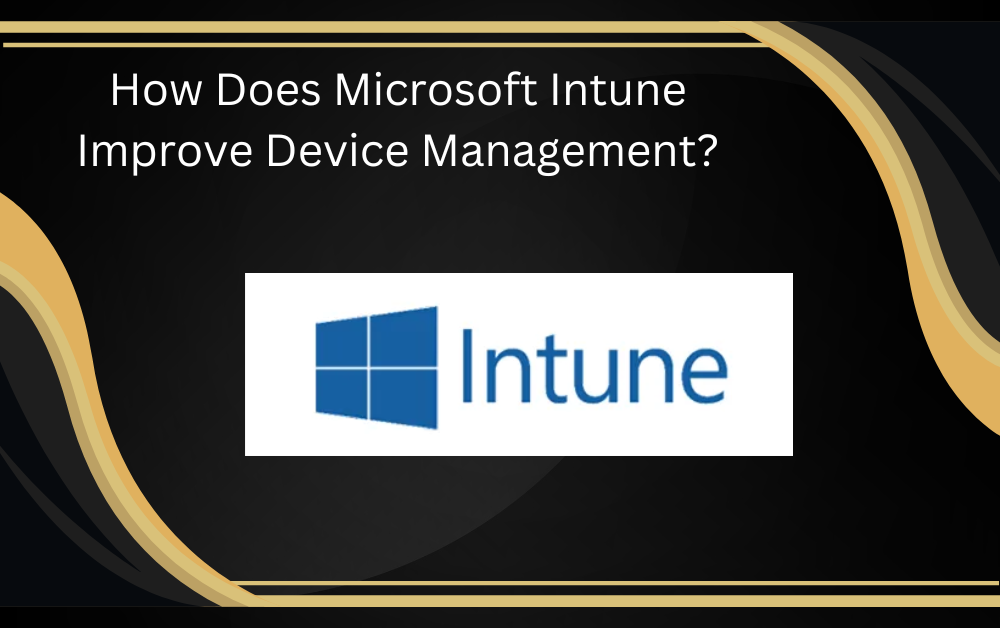Microsoft Intune is a cloud-based service that plays a pivotal role in modern enterprise device management. With businesses adopting flexible work environments and mobile devices, the need for effective device management has grown significantly. Intune ensures that devices are properly managed, secured, and compliant with organizational policies. The service offers a comprehensive suite of tools to manage mobile devices, desktop systems, and apps in a manner that enhances productivity while protecting sensitive data.
This article delves into how Microsoft Intune improves device management, providing a clear understanding of its features, advantages, and implementation.
NOTE: Microsoft Intune has revolutionized device management for organizations. Informa Global implemented Microsoft Intune in the past to streamline device management, ensuring seamless compliance and security for their clients.
What is Microsoft Intune?
Microsoft Intune is a part of Microsoft’s Enterprise Mobility + Security (EMS) suite, specifically designed for managing and securing mobile devices and applications. By leveraging Intune, businesses can enforce policies across a wide range of devices, including smartphones, tablets, and desktops. Intune helps organizations ensure that their workforce remains productive, regardless of the device they use, while protecting critical corporate data.
The platform supports both corporate-owned devices and employee-owned devices (BYOD – Bring Your Own Device), offering flexibility and control. With its cloud-based infrastructure, Intune is scalable and accessible from anywhere, making it ideal for businesses with remote or hybrid workforces.
Key Features of Microsoft Intune
Intune offers a variety of features aimed at enhancing device management. Some of the core capabilities include:
-
Mobile Device Management (MDM): MDM allows businesses to manage and secure mobile devices. It helps enforce policies such as device encryption, password strength requirements, and remote wipe capabilities if a device is lost or stolen.
-
Mobile Application Management (MAM): MAM enables businesses to control how apps are accessed and used within the organization. It can enforce app-specific policies, such as requiring a PIN for app access or restricting data sharing between apps.
-
Conditional Access: Intune’s conditional access policies provide additional layers of security by ensuring that only compliant devices can access corporate resources. If a device does not meet security requirements, it is blocked from accessing sensitive data.
-
Device Compliance Policies: These policies ensure that devices are compliant with organizational standards. For instance, they can enforce operating system version requirements, enforce encryption, or disable jailbroken devices.
-
Application Deployment: Intune allows for the deployment of apps to managed devices. This includes business apps, security apps, and even custom apps developed for the enterprise. Apps can be automatically installed, updated, and removed as needed.
Benefits of Using Microsoft Intune
The adoption of Microsoft Intune brings several advantages to organizations, ranging from enhanced security to streamlined management processes.
1. Enhanced Security
Microsoft Intune offers robust security features that ensure corporate data remains protected. With the ability to enforce encryption, secure access controls, and monitor device compliance, businesses can protect sensitive information from potential threats. The integration of Intune with Azure Active Directory (AAD) further strengthens security by enabling multi-factor authentication (MFA) and conditional access policies.
2. Seamless Integration with Microsoft 365
Intune seamlessly integrates with Microsoft 365, providing businesses with a unified platform for managing both productivity and security tools. Organizations can configure settings for Office apps, ensuring that only compliant devices can access documents and emails. This integration helps streamline operations by offering a centralized management console for both productivity and security solutions.
3. Scalability and Flexibility
Since Microsoft Intune is cloud-based, businesses can scale it according to their needs. Whether an organization has 10 devices or 10,000, Intune can handle the load. Moreover, because Intune is platform-agnostic, it supports a wide variety of operating systems, including Windows, macOS, iOS, and Android, providing a flexible solution for businesses with diverse device environments.
4. Simplified Device Management
Managing multiple devices across an organization can be a complex task, especially with a mobile workforce. Intune simplifies this process by offering a centralized console to manage all devices. Admins can easily push updates, configure security settings, and monitor device health from a single location.
5. Cost-Effectiveness
Microsoft Intune provides a cost-effective solution for managing devices. Unlike traditional on-premise solutions, which require significant hardware and infrastructure investments, Intune is a subscription-based service with no upfront costs. This reduces the total cost of ownership and provides businesses with a predictable, pay-as-you-go pricing model.
6. Remote Device Management
With remote work becoming more common, remote device management has become a necessity. Intune enables administrators to remotely manage and support devices, no matter where they are located. This means that devices can be configured, updated, and secured even if they are miles away from the office.
How Microsoft Intune Improves Device Management
The improvements that Microsoft Intune brings to device management can be broken down into several key areas:
1. Increased Productivity
By streamlining device management, Intune ensures that employees can access the tools and resources they need to be productive, whether they are working in the office or remotely. Automated app deployments and updates ensure that users always have the latest versions of apps without manual intervention, reducing downtime and enhancing productivity.
2. Policy Enforcement
Intune allows businesses to enforce strict security policies across their devices. These policies can range from basic password requirements to complex encryption and device wipe protocols. By enforcing these policies, organizations can reduce the risk of data breaches and unauthorized access to corporate information.
3. Improved Compliance
Intune helps businesses meet compliance standards, such as GDPR, HIPAA, and others. With features like compliance reporting, businesses can demonstrate that they are meeting regulatory requirements for data protection. The platform’s ability to track device health, monitor compliance, and generate reports makes it easier for organizations to remain compliant.
4. Flexibility for End Users
For employees, Microsoft Intune provides a seamless experience by allowing them to access corporate resources from their personal devices. With the BYOD capability, employees can use their preferred devices while still maintaining corporate security standards. This flexibility increases employee satisfaction and adoption of enterprise mobility solutions.
5. Centralized Control for IT Admins
From an IT administrator’s perspective, Intune provides centralized control over all devices and apps. Admins can easily configure devices, deploy apps, enforce security policies, and troubleshoot issues from a single, easy-to-use console. This reduces the complexity of device management and helps ensure a consistent user experience.
Best Practices for Implementing Microsoft Intune
When implementing Microsoft Intune, organizations should follow best practices to ensure a smooth rollout and successful adoption:
1. Start Small and Scale
Start by implementing Intune on a small set of devices or users before rolling it out across the entire organization. This allows your IT team to familiarize themselves with the platform and iron out any issues before scaling it further.
2. Train IT Staff
Ensure that your IT team is properly trained on how to use Intune’s features. Microsoft offers a range of training resources, including documentation, tutorials, and webinars, to help IT professionals get up to speed.
3. Use Security Baselines
Microsoft provides security baselines for Intune, which are pre-configured security policies based on industry standards. Using these baselines ensures that your devices are secure and compliant with best practices from the get-go.
4. Monitor and Report
Regularly monitor the health of your devices and compliance status using Intune’s reporting features. This allows you to quickly identify and address any security or compliance issues.
Conclusion
Microsoft Intune is an essential tool for businesses looking to manage and secure their devices in today’s fast-paced, mobile-first world. Its comprehensive features, combined with its flexibility, scalability, and seamless integration with other Microsoft services, make it an invaluable solution for organizations of all sizes. Whether you’re looking to enforce policies, ensure compliance, or improve productivity, Microsoft Intune offers the tools you need to keep your enterprise secure and running smoothly.
For More Insightful Articles Related To This Topic, Feel Free To Visit: coeruniversity







